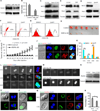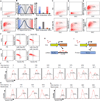A microRNA miR-34a-regulated bimodal switch targets Notch in colon cancer stem cells
- PMID: 23642368
- PMCID: PMC3646336
- DOI: 10.1016/j.stem.2013.03.002
A microRNA miR-34a-regulated bimodal switch targets Notch in colon cancer stem cells
Abstract
microRNAs regulate developmental cell-fate decisions, tissue homeostasis, and oncogenesis in distinct ways relative to proteins. Here, we show that the tumor suppressor microRNA miR-34a is a cell-fate determinant in early-stage dividing colon cancer stem cells (CCSCs). In pair-cell assays, miR-34a distributes at high levels in differentiating progeny, whereas low levels of miR-34a demarcate self-renewing CCSCs. Moreover, miR-34a loss of function and gain of function alter the balance between self-renewal versus differentiation both in vitro and in vivo. Mechanistically, miR-34a sequesters Notch1 mRNA to generate a sharp threshold response where a bimodal Notch signal specifies the choice between self-renewal and differentiation. In contrast, the canonical cell-fate determinant Numb regulates Notch levels in a continuously graded manner. Altogether, our findings highlight a unique microRNA-regulated mechanism that converts noisy input into a toggle switch for robust cell-fate decisions in CCSCs.
Copyright © 2013 Elsevier Inc. All rights reserved.
Figures






Comment in
-
miR-34a sets the "sweet spot" for notch in colorectal cancer stem cells.Cell Stem Cell. 2013 May 2;12(5):499-501. doi: 10.1016/j.stem.2013.04.018. Cell Stem Cell. 2013. PMID: 23642356
References
-
- Alison MR, Lin WR, Lim SM, Nicholson LJ. Cancer stem cells: in the line of fire. Cancer treatment reviews. 2012;38:589–598. - PubMed
-
- Arrowsmith J. Trial watch: Phase II failures: 2008–2010. Nature reviews Drug discovery. 2011a;10:328–329. - PubMed
-
- Arrowsmith J. Trial watch: phase III and submission failures: 2007–2010. Nature reviews Drug discovery. 2011b;10:87. - PubMed
Publication types
MeSH terms
Substances
Grants and funding
LinkOut - more resources
Full Text Sources
Other Literature Sources

